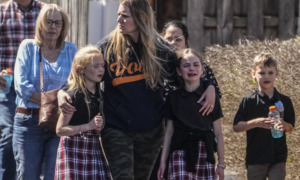 (We are rerunning this column from 2016 because it remains extremely relevant in this time of recent school shootings in Florida and California.)
(We are rerunning this column from 2016 because it remains extremely relevant in this time of recent school shootings in Florida and California.)
The philosophy of trauma-informed care is becoming more and more embedded in the philosophies and practices of child-serving agencies.
When a child experiences a single traumatic event and is fortunate enough to be surrounded by supportive and nurturing adults, that trauma can generally be assessed and usually treated effectively with the help of parental support. When a traumatized child responds with internalized distress such as sadness, depression or anxiety, our systems appear to understand what that child needs to help in their healing and recovery.
However, when a child has experienced multiple and complex trauma, child-serving professionals, including those in behavioral health, child welfare, juvenile justice and educators, can struggle to see the connection between such histories and other common presentations.
It is not uncommon for children with histories of complex trauma to respond with externalizing behaviors and to be diagnosed with disruptive behavior disorders such as attention deficit hyperactivity disorder, oppositional defiant disorder or conduct disorder. Sometimes children also respond with agitated depression and anxiety. These are the children who may at times rage, fight, argue, refuse to comply, run away, lie and steal.
Why the disconnect between trauma experiences and disruptive behavior disorders? The Diagnostic and Statistical Manual of Mental Disorders, Fifth Edition (DSM-V) does not yet adequately capture the experiences of trauma in children. Instead, the available diagnoses capture only parts of a child’s trauma experiences and presentation.
The problem that I see with this is that an individual diagnosis guides treatment intervention and interventions may or may not include the specific treatment of the trauma. When children are diagnosed with depression or anxiety, it is the depression or anxiety that is targeted in the treatment, rather than the trauma, which is sometimes also the primary issue. When children are diagnosed with disruptive behavior disorders, targeted intervention tends to focus on these behaviors or the secondary symptoms of the trauma, rather than the trauma history itself.
When we think of trauma responses in the simplest form, we think of the “fight-flight-freeze” responses common in traumatized children. The “fight” response can present as verbal or physical aggression; the “flight” response can present as avoidance or refusal, and the “freeze” response can present as dissociation, daydreaming or numbing.
In turn, I see corresponding reactions from child-serving professionals who work with traumatized children. These are the children who can trigger countertransference reactions in the professionals meant to serve them.
The professionals can have a “fight” reaction, which can present as frustration, anger and punitive treatment recommendations; a “flight” response, which can present as child or case avoidance, feeling of hopelessness and referral elsewhere, or a “freeze” response, which can present as a feeling of helplessness or impotence in working with the child or not knowing what to do, so doing nothing.
I see these nontrauma-informed responses toward systems-involved children from both highly trained professionals and those with limited training in behavioral health, child welfare, juvenile justice, and education. Such triggers can elicit our own “fight-flight-freeze” responses to these children presenting with “fight-flight-freeze” reactions to ongoing trauma triggers.
When a trauma-informed approach is being fully used, the behaviors of these children should be seen as “normal” secondary reactions to the trauma they have and are still experiencing. An approach that is not fully trauma-informed will view these children’s behaviors as volitional, purposeful, manipulative and in need of significant consequences.
That is not to say that children should not receive consequences for their behavior. However, such consequences should be focused on teaching appropriate behavior rather than punishing the behavior, especially by escalated means when initial attempts are not successful.
Not uncommonly, staff serving a child agency are overwhelmed with the numbers of child with significantly complex needs, enormous corresponding paperwork requirements and strict deadlines. These working conditions can make otherwise caring, concerned and patient staff less so. Staff have varying degrees of education, experience and quality of ongoing training and supervision. Thus, it is not unusual when staff are triggered by children who challenge their authority or are not engaged.
Our responses of frustration, anger, avoidance and hopelessness only reinforce the same feelings in traumatized children. There is a saying in the school counseling field: “Those children needing the most love will ask for it in the most unloving ways.”
It is easy to react in a trauma-informed manner when a child is responsive and appreciative of our efforts, and treats us with respect. It is harder to respond effectively when that child refuses to talk to us, comply with our requests, tells us off in colorful language or otherwise acts disrespectfully. But these are the children who need us the most.
Luckily, there is training and education available on the neurobiology of trauma. This is the important and emerging research that is connecting the effects of trauma to different domains of a child’s functioning. The domains that can be affected include behavioral, cognitive, emotional and relational functioning.
Without understanding the common effects of trauma in a child’s functioning, the obvious conclusion is that these children are behaving in volitional and manipulative means. If it is understood that these children have difficulty modulating their impulses and are responding in survival (fight-flight-freeze) mode, this allows for a more patient, respectful and positive intervention.
Understanding that these children’s central nervous systems are activated and in need of calming allows us the patience to work with children in calm and respectful ways and reminds us that traumatized children do not “get it” the first, second or third time. Plus, traumatized children do not wake up one day to trust you because you believe you are a trustworthy person. When we understand the effects of trauma, especially pertaining to disruptive behavior, we are better prepared to be with and to help these children.
Most children behave or wish to behave well. Most children want adult respect, love and guidance. Most of those who do not behave well have not yet learned how to behave well and will need lots of time and practice with our guidance.
Our negative responses to disruptive behavior can and do reinforce the misbehavior. In turn, most child-serving professionals like and want to work with children, even if we sometimes do not know how to do so.
Beverly Tobiason, Psy.D., is the clinical director at Pima County Juvenile Court Center in Tucson, Arizona. She can be reached at Beverly.tobiason@pcjcc.pima.gov































